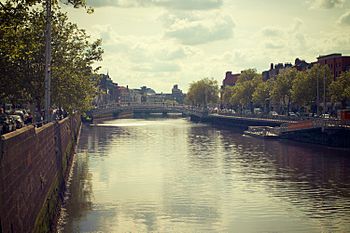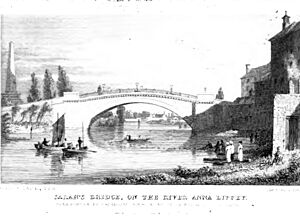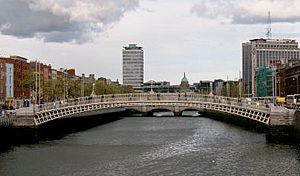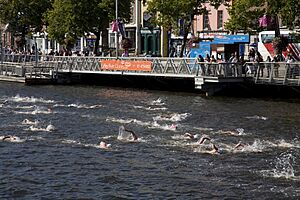River Liffey facts for kids
Quick facts for kids River Liffey |
|
|---|---|

Boardwalks of Liffey from O'Connell Bridge, in Dublin
|
|
| Country | Ireland |
| Physical characteristics | |
| Main source | Kippure, County Wicklow 500 m (1,600 ft) |
| River mouth | Irish Sea at Dublin Bay |
| Length | 125 km (78 mi) |
| Basin features | |
| Basin size | 1,256 km2 (485 sq mi) |
| Tributaries |
|
The River Liffey (called An Life in Irish) is an important river in Ireland. It flows right through the middle of Dublin, the capital city. This river provides a lot of the drinking water for Dublin. Some of the main rivers that flow into the Liffey are the River Dodder, the River Poddle, and the River Camac.
Contents
What's in a Name? The Liffey's History
Before it was called the Liffey, the river had another name: An Ruirthech. This old name meant "fast runner" or "strong runner," which makes sense for a river!
The name Liphe (or Life) originally belonged to the flat area of land, or plain, that the river flowed through. Over time, people started using this name for the river itself. You might also hear it called the Anna Liffey. This probably comes from the Irish phrase for "River Liffey," which is Abhainn na Life. It sounds a lot like "Anna Liffey" when spoken in English.
Where the Liffey Flows
The Liffey begins high up in the Wicklow mountains. It starts as many small streams in a boggy area called Liffey Head Bog, between Kippure and Tonduff.
The river then travels for about 125 km (78 mi) (around 78 miles). It passes through three counties: Wicklow, Kildare, and Dublin. Most of its journey is actually in County Kildare. Finally, the Liffey flows into the Irish Sea at the middle of Dublin Bay.
Rivers Joining the Liffey
The Liffey has many tributaries. These are smaller rivers or streams that flow into a larger river. Some of its most important tributaries include the King's River, the River Dodder, the River Poddle, and the River Camac.
Natural Features and Dams
The Liffey doesn't have any natural lakes along its path. It also has only a few small islands. As the river gets closer to Dublin city, you can find some areas with rapids, where the water flows quickly over rocks.
There are three dams built on the river. These dams help create electricity using the power of the water, which is called hydroelectric power. These power stations are located at Poulaphouca, Golden Falls, and Leixlip. A very large reservoir, which is like a big artificial lake, was built at Poulaphouca.
Towns Along the River
Many towns are located along the banks of the River Liffey before it reaches Dublin city. These include Ballymore Eustace, Athgarvan, Kilcullen, Newbridge, Caragh, Clane, Celbridge, Leixlip, and Lucan.
How the Liffey is Used
For many hundreds of years, the River Liffey in Dublin city has been used for trade. The Vikings used the river a long time ago, and it was still used for shipping until recently. The Liffey is connected to the River Shannon by two canals: the Grand Canal and the Royal Canal. These canals allow boats to travel from Dublin all the way to the west of Ireland.
Drinking Water Supply
About 60% of the water flowing in the Liffey is used for drinking water and for businesses. Much of this water is cleaned at special treatment plants and then returned to the river. There's a common story that Guinness beer is made with Liffey water, but that's not true! Guinness uses water that comes from the Wicklow mountains through pipes.
River Traffic
In the past, special cargo ships named Lady Patricia and Miranda Guinness were a common sight on the Liffey. They were used to carry Guinness beer from the St. James's Gate Brewery to other places. These ships were used until the 1990s.
Today, the main boats you'll see on the river in the city are those offering guided tours of Dublin. Further downstream, past the East-Link bridge, the river is still used by commercial ships and ferries.

Fun Activities on the Liffey
The Liffey is also used for sports and fun! Private clubs, university teams, and even the police (Garda) have rowing clubs in Chapelizod.
A big canoeing event called the Liffey Descent happens every year. It's a 27 km (17 mi) (about 17-mile) race from Straffan to Islandbridge. This race has been held every year since 1960. There's also an annual swimming race called The Liffey Swim. It takes place in late August or early September, between Watling Bridge and The Custom House.
Bridges Over the Liffey
The River Liffey divides Dublin into two main parts: the Northside and the Southside. Many bridges connect these two sides, and most of them are open for cars, trucks, and buses.
History of Liffey Bridges
The very first stone bridge over the Liffey was called the Bridge of Dublin. It was built in 1428 by a group of monks called the Dominicans. This bridge lasted a long time, well into the 1700s. It replaced an older wooden bridge that was in the same spot. Later, Island Bridge was added in 1577.
As Dublin became a busy city in the 1600s, four new bridges were built between 1670 and 1684. These included Barrack (now Rory O'More Bridge), Essex Bridge (now Grattan Bridge), Ormond Bridge (now O'Donovan Rossa Bridge), and Arran Bridge.
The oldest bridge still standing today is the Mellows Bridge. It was built in 1764 after the Arran Bridge, which was there before it, was washed away by floods in 1763.
The first bridge made of iron was the beautiful Ha'penny Bridge, built in 1816. The newest bridge is the Samuel Beckett Bridge, which opened in December 2009. It's a special type of bridge called a suspension bridge that can actually move to let boats pass underneath!
Modern Bridges
Some of the large bridges in Dublin include the West-Link Bridge on the M50 motorway, the Seán Heuston Bridge, and O'Connell Bridge.
There are also three bridges in the city just for people walking: the Millennium Bridge, the Seán O'Casey Bridge, and the famous Ha'penny Bridge.
Outside of Dublin, you can find other bridges over the Liffey. These include the Liffey Bridge at Celbridge, "The Bridge at 16" (a pedestrian suspension bridge from the 1800s), and the Leinster Aqueduct. This aqueduct is a bridge that carries the Grand Canal over the Liffey at Caragh.
Images for kids
-
"Sarah's Bridge on the River Anna Liffey" (1831). Sarah's Bridge is today called Island Bridge. The then-new Wellington Monument is seen on the left.
-
The ship Jeanie Johnston on the River Liffey.
See also
 In Spanish: Río Liffey para niños
In Spanish: Río Liffey para niños






